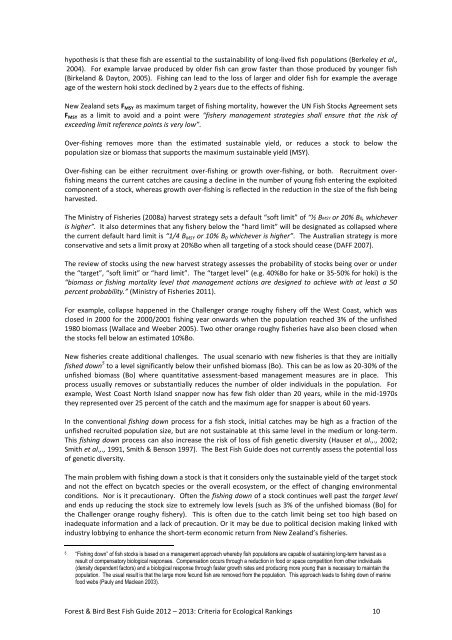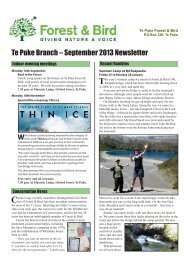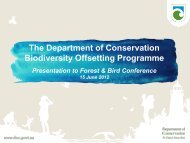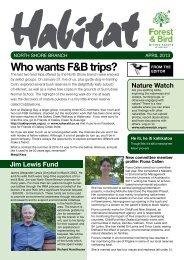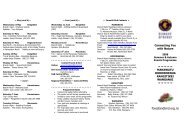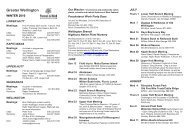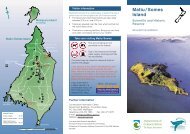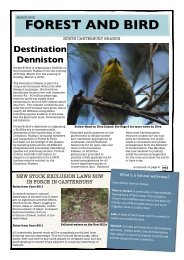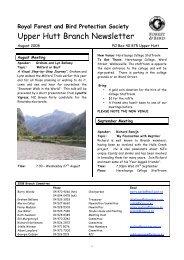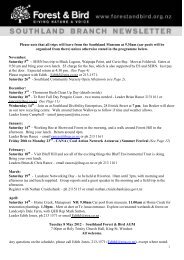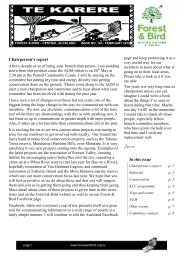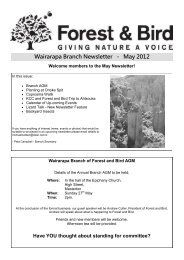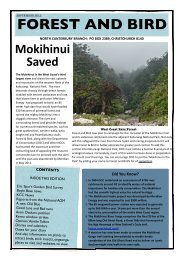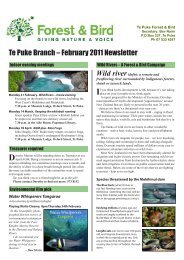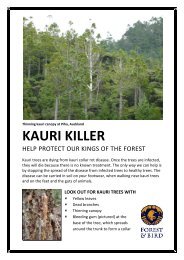methodology - Forest and Bird
methodology - Forest and Bird
methodology - Forest and Bird
You also want an ePaper? Increase the reach of your titles
YUMPU automatically turns print PDFs into web optimized ePapers that Google loves.
hypothesis is that these fish are essential to the sustainability of long-lived fish populations (Berkeley et al.,<br />
2004). For example larvae produced by older fish can grow faster than those produced by younger fish<br />
(Birkel<strong>and</strong> & Dayton, 2005). Fishing can lead to the loss of larger <strong>and</strong> older fish for example the average<br />
age of the western hoki stock declined by 2 years due to the effects of fishing.<br />
New Zeal<strong>and</strong> sets FMSY as maximum target of fishing mortality, however the UN Fish Stocks Agreement sets<br />
FMSY as a limit to avoid <strong>and</strong> a point were “fishery management strategies shall ensure that the risk of<br />
exceeding limit reference points is very low”.<br />
Over-fishing removes more than the estimated sustainable yield, or reduces a stock to below the<br />
population size or biomass that supports the maximum sustainable yield (MSY).<br />
Over-fishing can be either recruitment over-fishing or growth over-fishing, or both. Recruitment overfishing<br />
means the current catches are causing a decline in the number of young fish entering the exploited<br />
component of a stock, whereas growth over-fishing is reflected in the reduction in the size of the fish being<br />
harvested.<br />
The Ministry of Fisheries (2008a) harvest strategy sets a default “soft limit” of “½ BMSY or 20% B0, whichever<br />
is higher”. It also determines that any fishery below the “hard limit” will be designated as collapsed where<br />
the current default hard limit is “1/4 BMSY or 10% B0 whichever is higher”. The Australian strategy is more<br />
conservative <strong>and</strong> sets a limit proxy at 20%Bo when all targeting of a stock should cease (DAFF 2007).<br />
The review of stocks using the new harvest strategy assesses the probability of stocks being over or under<br />
the “target”, “soft limit” or “hard limit”. The “target level” (e.g. 40%Bo for hake or 35-50% for hoki) is the<br />
“biomass or fishing mortality level that management actions are designed to achieve with at least a 50<br />
percent probability.” (Ministry of Fisheries 2011).<br />
For example, collapse happened in the Challenger orange roughy fishery off the West Coast, which was<br />
closed in 2000 for the 2000/2001 fishing year onwards when the population reached 3% of the unfished<br />
1980 biomass (Wallace <strong>and</strong> Weeber 2005). Two other orange roughy fisheries have also been closed when<br />
the stocks fell below an estimated 10%Bo.<br />
New fisheries create additional challenges. The usual scenario with new fisheries is that they are initially<br />
fished down 5 to a level significantly below their unfished biomass (Bo). This can be as low as 20-30% of the<br />
unfished biomass (Bo) where quantitative assessment-based management measures are in place. This<br />
process usually removes or substantially reduces the number of older individuals in the population. For<br />
example, West Coast North Isl<strong>and</strong> snapper now has few fish older than 20 years, while in the mid-1970s<br />
they represented over 25 percent of the catch <strong>and</strong> the maximum age for snapper is about 60 years.<br />
In the conventional fishing down process for a fish stock, initial catches may be high as a fraction of the<br />
unfished recruited population size, but are not sustainable at this same level in the medium or long-term.<br />
This fishing down process can also increase the risk of loss of fish genetic diversity (Hauser et al.,., 2002;<br />
Smith et al.,., 1991, Smith & Benson 1997). The Best Fish Guide does not currently assess the potential loss<br />
of genetic diversity.<br />
The main problem with fishing down a stock is that it considers only the sustainable yield of the target stock<br />
<strong>and</strong> not the effect on bycatch species or the overall ecosystem, or the effect of changing environmental<br />
conditions. Nor is it precautionary. Often the fishing down of a stock continues well past the target level<br />
<strong>and</strong> ends up reducing the stock size to extremely low levels (such as 3% of the unfished biomass (Bo) for<br />
the Challenger orange roughy fishery). This is often due to the catch limit being set too high based on<br />
inadequate information <strong>and</strong> a lack of precaution. Or it may be due to political decision making linked with<br />
industry lobbying to enhance the short-term economic return from New Zeal<strong>and</strong>’s fisheries.<br />
5 ―Fishing down‖ of fish stocks is based on a management approach whereby fish populations are capable of sustaining long-term harvest as a<br />
result of compensatory biological responses. Compensation occurs through a reduction in food or space competition from other individuals<br />
(density dependent factors) <strong>and</strong> a biological response through faster growth rates <strong>and</strong> producing more young than is necessary to maintain the<br />
population. The usual result is that the large more fecund fish are removed from the population. This approach leads to fishing down of marine<br />
food webs (Pauly <strong>and</strong> Maclean 2003).<br />
<strong>Forest</strong> & <strong>Bird</strong> Best Fish Guide 2012 – 2013: Criteria for Ecological Rankings 10


